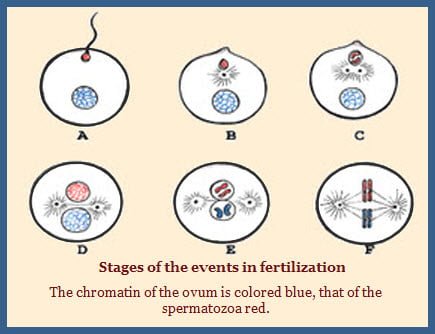Fertilization in Animals
The sperm can enter the ovum at any point on its circumference. In many mammals, entire sperm is known to pass into the cytoplasm of the ovum. After the entry of the sperm, the second polar body is extruded and the chromosomes, which remain in the ovum, reconstitute themselves into a vesicular nucleus, the female pronucleus. The vitellus shrinks so that a distinct perivitelline space is present.

The head of the sperm undergoes changes after it enters the ovum. It swells up and becomes transformed into the male pronucleus. The middle piece and the tail persist for sometime and later disappear and are probably absorbed into the cytoplasm of the ovum.
After the head of the sperm becomes detached from the middle piece and tail, it probably rotates through 180 ° and the two pronuclei meet roughly in the center of the ovum.
A centrosome, which is possibly derived from the proximal centriole of the sperm, now becomes distinct. It divides into two parts, each of which is attached to a pole of the spindle, which now makes its appearance. At the same time, each pronucleus resolves itself into chromosomes and the nuclear membranes disappear. The chromosomes of both pronuclei arrange themselves on the spindle and each splits into halves passing towards the chromosomes.
The polar bodies persist for a variable time in the perivitelline space but later they degenerate and disappear.






